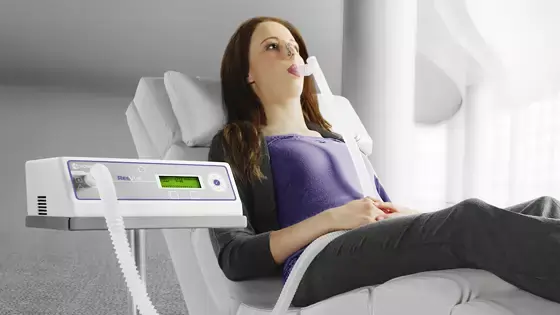Metabolic Rate Testing
Overview
The energy your body needs to function is produced by your metabolism from the calories you eat. Continue reading to find out what metabolic testing entails and how to apply the findings.
If your metabolism is higher, you will have an easier time losing weight and keeping it off. Metabolic testing is one method to find out how quickly your body is metabolizing food. To learn more about metabolic testing and how to use the results to enhance your physical fitness and reduce weight, continue reading.
Metabolic Rate Testing: What Is It?
A variety of assays are used in metabolic testing. Every test tells you something important about your metabolism. They are:
Metabolic rate at rest (RMR). You can find out how many calories you burn when your body is at rest, meaning you aren’t moving or exercising, by testing this part of your metabolism. Air maximum volume (V02 Max). This test component, also known as aerobic capacity, tells you how well your body uses oxygen when you exercise.
Test for lactate threshold. The point at which lactic acid accumulates in the blood more quickly than it can be eliminated during activity, leading to muscle tiredness, is known as your lactate threshold.
Where Can You Get Tested?
In a health care facility or gym
Traditionally, metabolic testing has been carried out in medical settings. These days, a lot of fitness centers and health clubs provide this kind of test.
Some users believe that metabolic tests conducted at fitness centers are less accurate than those conducted by medical professionals because certification is not necessary to evaluate the findings.
Consult a physician about locating a trustworthy testing facility in your area if you’re interested in getting your metabolism examined. Be aware that metabolic testing is typically costly and that insurance may not always cover it.
Home Testing
You might also want to think about at-home testing. Hormone levels that can impact metabolism are examined by the majority of at-home metabolism tests, including:
- Cortisol
- Insulin
- Progesterone
- Thyroid hormone triiodothyronine (T3)
This is not the same as metabolic rate, although it can be helpful.
How a Fitness Center Or Medical Facility Tests Your Metabolism
Resting Metabolic Rate (RMR)
A calorimetry test is nearly always included in metabolic testing, which is usually conducted in multiple steps. You must lie down for 15 to 30 minutes to complete this exam.
There may be variations in the equipment utilized. A mouthpiece that you breathe into is used in certain calorimetry tests. Others have you lie down behind a plastic hood that is connected by a tube to a monitor.
Maximum Volume Of Oxygen (V02 max)
When engaging in aerobic exercise, like walking or jogging on a treadmill, your V02 max is measured. The ability to breathe into an oxygen mask is part of this test.
The treadmill’s speed and inclination will keep rising as the test goes on. Your degree of fitness and your capacity to persevere as the exam gets harder will decide how long it takes you to complete.
Each test’s results are examined using particular formulas that compare the inhalation of oxygen and the emission of carbon dioxide.
This enables your trainer or healthcare practitioner to calculate how many calories you burn during activity and at rest.
Lactate Threshold
Your blood will be taken at different intervals while you increase your aerobic activity levels on a bike or treadmill if you have lactate threshold testing done.
Only a medical setting should be used for this test.
Is It Possible To Work With Metabolic Testing For Fitness And Weight Loss?
Metabolic testing provides you with an estimate of your daily caloric expenditure. With this knowledge, you can change your diet or level of physical activity to increase (or decrease) your daily caloric expenditure.
Although metabolic testing has its uses, the results should be considered in the context of a larger fitness or health program.
The ideal V02 MAX and RMR values differ for each individual. They are predicated on numerous elements, such as:
- Age
- Gender
- Activity level
- Weight history
- Current weight
Consider that your test results give you a quick overview of your fitness level and metabolism on the day of the test. Your metabolic rate and statistics will fluctuate if your level of activity varies or if your physical fitness increases or decreases.
Can you alter your metabolism to speed it up or slow it down?
By changing your lifestyle, you can safely increase or decrease your metabolic rate.
Exercise
When you are active, you burn more calories than when you are at rest. The more intense the activity, the more calories you will burn and the higher your metabolic rate.
Exercise also increases your metabolism for a few hours after you stop. Your fitness regimen may also have an impact. Exercise that is both aerobic and anaerobic can increase metabolic rate. See your doctor about a safe exercise regimen if you’re elderly, highly inactive, or have a BMI above thirty.
To increase your metabolism, though, you don’t need to go to the gym every day. Little bursts of exercise, like taking short walks or standing rather than sitting, can be beneficial.
Your general health depends on eating a balanced diet that contains lean meats, whole grains, fruits, and vegetables. Note that along with eating a balanced diet, it’s critical to maintain portion control at every meal. You will usually gain weight if you consume more calories than you expend. Eating too few calories, however, can have a side effect of slowing down your metabolism.
Metabolic Rate Measurement: Gaining Understanding about Your Health
A clinical approach for understanding the way your body uses energy is metabolic rate testing. It helps customize diet and exercise regimens for optimum health and performance by offering insightful information about your caloric requirements. An extensive examination of metabolic rate testing and its advantages may be found here.
Why Take a Metabolic Rate Test?
Knowing your metabolic rate can help you:
- Personalize Nutrition Plans: Determine your unique calorie requirements to meet objectives such as muscle growth, weight loss, or maintenance.
- Optimize Your Workout Routines: Modify the length and intensity of your workouts according to how your body uses energy.
- Find Metabolic Disorders: Look for diseases that may impact energy expenditure, such as hyperthyroidism or hypothyroidism.
- Prevent Over- or Under-Eating: Make sure your calorie consumption is in line with your body’s true needs to avoid frequent diet planning errors.
How Do You Test for Metabolic Rate?
Usually, metabolic rate testing entails:
The most widely used technique for estimating energy expenditure is indirect calorimetry, which monitors carbon dioxide production and oxygen consumption. This is carried out by:
- Breathing for ten to thirty minutes into a specialized apparatus.
- For accuracy, make sure the test is administered while fasting and resting.
- Minimal activity levels are included in the Resting Metabolic Rate (RMR) measurement, a subset of BMR testing.
- Activity-Based Measurements: Occasionally used to estimate TDEE in conjunction with wearable technology or surveys.
Preparing for the Test
To guarantee precise outcomes:
- For eight to twelve hours, you should only eat or drink water.
- Avoid Exercise: For at least 24 hours, refrain from engaging in any physical activity.
- Limit Stimulants: On the day of the test, stay away from nicotine and coffee.
- Remain calm: Stress might affect measurements of metabolic rate.
Metabolic Rate Testing Advantages
Improved Weight Management: Setting reasonable calorie objectives for weight goals is made easier when you are aware of your metabolic rate.
- Enhanced Athletic Performance: Customized diet and exercise regimens help optimize energy efficiency.
- Improved Knowledge of Your Body: Learn how metabolism is impacted by age, genetics, and lifestyle.
- Early Health Issue Detection: Look for unusual metabolic abnormalities that can point to underlying diseases.
For whom is metabolic rate testing appropriate?
Testing metabolic rates is advantageous for:
- People who are having trouble gaining or losing weight.
- Athletes looking to maximize their performance.
- Those who may have thyroid or metabolic problems.
- Anyone looking for a customized approach to wellness and health.
Restrictions & Things to Think About
Although metabolic rate measurement provides insightful information, it is crucial to:
- Combine Findings with Expert Advice: See a nutritionist or healthcare professional to evaluate findings and develop a thorough plan.
- Understand Variability: Illness, hormonal changes, and environmental conditions can influence metabolic rate.
- Avoid Over-Reliance: Use metabolic rate testing as a tool, not the sole determinant of health strategies.
Conclusion
A useful technique for figuring out how much energy your body needs and enhancing general health is metabolic rate testing. You can make better judgments about your nutrition, exercise, and lifestyle by having a better understanding of your calorie needs.
This test can help you reach your health objectives, whether they be to improve your sports performance, reduce weight, or just learn more about your metabolism.
FAQs
Metabolic rate testing: what is it?
The number of calories your body uses at rest to sustain essential physical processes like breathing, circulation, and cell creation is measured by metabolic rate testing. It assists in calculating your basal metabolic rate (BMR) or resting metabolic rate (RMR).
How is a test of metabolic rate conducted?
Indirect calorimetry, in which a subject breathes into a device that monitors the amount of oxygen consumed and carbon dioxide produced, is commonly used for metabolic rate assessment. This method allows for the estimation of energy expenditure.
How do BMR and RMR differ from one another?
The number of calories your body requires to function at total rest is known as your basal metabolic rate, or BMR. Similar to BMR, resting metabolic rate (RMR) is usually evaluated under less stringent conditions and is frequently marginally higher.
What is the significance of metabolic rate testing?
It promotes the creation of individualized diet and activity plans, helps identify a person’s calorie requirements for weight management, and may reveal irregularities or problems with metabolic health.
What is the purpose of testing my metabolic rate?
Measuring your metabolic rate can be beneficial.
Calculate the number of calories your body burns while at rest.
Adapt your diet and exercise regimens to your metabolism.
Determine whether your metabolism is abnormally fast or sluggish. This may be a factor in your inability to control your weight.
For athletes or anyone aiming to increase their level of fitness, maximize performance, and health results.
Which two kinds of metabolic testing are there?
Medical tests are used by healthcare professionals to assess your metabolism or the general health of your body. The basic metabolic panel (BMP) and comprehensive metabolic panel (CMP) are the two blood tests that healthcare providers most frequently utilize. Every test looks at several vital components in your blood.
What is the ideal age for metabolic rate?
Your actual age should be fairly close to a healthy metabolic age. A healthy, balanced metabolic age is between 35 and 45 if you are 40. As long as it’s not too low, it’s acceptable for your metabolic age to appear younger than your true age.
A low metabolic rate: what is it?
The reality about metabolism Some people find it difficult to lose weight by just reducing their caloric intake since a slow metabolism burns fewer calories, which means more calories remain as fat in the body. Some people can eat a lot and not acquire extra weight because they burn calories more quickly when they have a fast metabolism.
What is a woman’s ideal metabolic rate?
Depending on the individual and their objectives, many things are deemed “healthy.” According to her, the typical BMR for men and women is roughly 1700 and 1400 kcal, respectively. You and your workout partner may have different BMRs even if you are the same age, sex, height, weight, and body composition.
Which blood test is the best for metabolism?
The CMP blood test measures important components to provide information about your liver, kidneys, and metabolism. Your metabolism is the engine that powers all of your body’s energy, converting the food you eat into fuel for essential processes like breathing, heart rate, and brain function.
What is the typical metabolic rate range?
An average woman’s daily BMR is approximately 5,900 kJ, but an average man’s is approximately 7,100 kJ. Although the rate of energy expenditure fluctuates during the day, it is constant. Early in the morning is often when the rate of energy expenditure is lowest.
Which drug is better for metabolic syndrome?
In individuals with metabolic syndrome, treatment for hyperglycemia usually begins with an insulin-sensitizing medication, such as metformin. According to some research, metformin may aid in reversing the pathophysiologic alterations associated with metabolic syndrome.
References
- Whelan, C. (2024, September 9). What is metabolic testing and can you use the info it provides to lose weight and improve fitness? Healthline. https://www.healthline.com/health/what-is-a-metabolism-test-and-can-you-use-it-for-weight-loss-and-fitness
- Fletcher, J. (2024, June 26). Best At-Home Metabolism Tests in 2024. https://www.medicalnewstoday.com/articles/at-home-metabolic-tests
- Metabolic testing. (n.d.). https://www.riversideonline.com/en/medical-services/wellness-and-fitness/clinical-wellness/metabolic-testing
- Resting metabolic rate testing. (2024, June 27). University of Utah Health | University of Utah Health. https://healthcare.utah.edu/integrative-health/services/fitness/testing/resting-metabolic-rate
- Metabolic Testing | Weight loss services | Mercy Health. (n.d.). https://www.mercy.com/health-care-services/bariatrics-medical-weight-loss/treatments/metabolic-testing



2 Comments